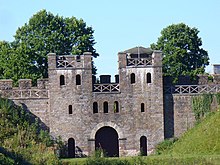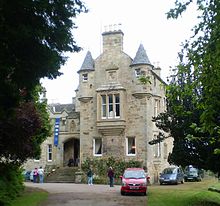
Caer (Welsh pronunciation: [kɑːɨr]; Old Welsh: cair or kair) is a placename element in Welsh meaning "stronghold", "fortress", or "citadel", roughly equivalent to an Old English suffix (-ceaster) now variously written as -caster, -cester, and -chester.
In modern Welsh orthography, caer is usually written as a prefix, although it was formerly—particularly in Latin—written as a separate word. The Breton equivalent is kêr, which is present in many Breton placenames as the prefix Ker-.
Etymology
The term is thought to have derived from the Brittonic *kagro- and to be cognate with cae ("field, enclosed piece of land"). Although stone castles were largely introduced to Wales by the invading Normans, "caer" was and remains used to describe the settlements around some of them as well. An example is the Roman fort at Caernarfon, formerly known in Welsh as Caer Seiont from its position on the Seiont; the later Edwardian castle and its community were distinguished as Caer yn Arfon ("fort in Arfon", the latter being a district name (Cantref Arfon) from "ar Fôn", "(land) opposite Môn or Anglesey"). However, the modern names of the Roman fort and Edwardian castle themselves are now Segontiwm or Castell Caernarfon, while the communities carry on the name caer.
Note that the term is not believed to be related to the Irish cathair ("city"), which is instead derived from Proto-Celtic *katrixs, *catarax ("fortification").
Britain
Gildas's account of the Saxon invasions of Britain claimed that there were 28 fortified Roman cities (Latin: civitas) on the island, without listing them. The History of the Britons traditionally attributed to Nennius includes a list of the 28, all of which are called "caer". Controversy exists over whether this list includes only Roman cities or a mixture of Roman cities and non-Roman settlements. Some of the place names that have been proposed include:

- Cair Brithon ("Fort of the Britons": Dumbarton in Strathclyde)
- Cair Caratauc ("Fort Rampart": Salisbury? Sellack?)
- Cair Ceint ("Fort Kent": Canterbury)
- Cair Celemion (Camalet? Silchester?)
- Cair Colun ("Fort Colonia": Colchester?)
- Cair Custoeint ("Fort Constantius or Constantine": Caernarfon; or poss. a Devonian hillfort)
- Cair Daun ("Fort Don": Doncaster)
- Cair Draitou (Drayton? Dunster?)
- Cair Ebrauc ("Fort York": York)
- Cair Grauth ("Fort Granta": Cambridge)
- Cair Guent ("Fort Venta": Caerwent or Winchester)
- Cair Guinntguic ("Fort Venta": Winchester? Norwich or Winwick?)
- Cair Guiragon ("Fort Weorgoran": Worcester)
- Cair Guorthigirn ("Fort Vortigern": Little Doward? Carmarthen?)
- Cair Guricon (Warwick? Wroxeter?)
- Cair Legeion Guar Usic ("Fort Legion on the Usk": Caerleon-upon-Usk)
- Cair Legion ("Fort Legion": Chester)
- Cair Lerion ("Fort Leir": Leicester)
- Cair Ligualid ("Fort Luguwalos": Carlisle)
- Cair Luit Coyt ("Fort Grey Wood": Wall)
- Cair Lundem ("Fort Londinium": London)
- Cair Maunguid (Manchester?)
- Cair Meguaid ("Fort Mediolanum": Meifod? Llanfyllin? Caersws? in Powys)
- Cair Mincip ("Fort Municipium": St Albans)
- Cair 'Pensa vel Coyt' ("Fort Penselwood": Exeter? Ilchester?)
- Cair Peris (Portchester? Builth Wells?)
- Cair Segeint ("Fort Seiont": Caernarfon; or poss. Silchester)
- Cair Urnarc (Wroxeter? Dorchester?)
Wales


The element caer, sometimes anglicized as car, is found in several place-names in Wales such as:
- Caerau, Glamorgan ("Forts")
- Caereinion, Montgomeryshire ("Fort on the Einion")
- Caerfallwch, Flintshire ("Afallach's fort")
- Caerfarchell, Pembrokeshire ("Marchell's fort")
- Carmarthen, Carmarthenshire (Caerfyrddin, "Merlin's fort").
- Caergeiliog, Anglesey ("Fort of the cockrell")
- Caergwrle, Flintshire ("Fort of the crane-wood")
- Caerleon, Glamorgan (Caerllion, "Fort Legion")
- Caernarfon, Caernarfonsire ("Fort Arfon")
- Caerphilly, Glamorgan (Caerffili, "Fort Ffili")
- Caerrhun, Caernarfonshire ("Fort of Rhun")
- Caersws, Montgomeryshire ("Susan's fort")
- Caerwent, Monmouthshire ("Fort Venta")
- Cardiff, Glamorgan (Caerdydd, "Fort Taf")
- Carew, Pembrokeshire
- Gaerwen, Anglesey (Caerwen, "white fort")
- Holyhead, Anglesey (Caergybi, "Fort Cybi")
England
The Cumbric language was spoken in Northern England until the Medieval era in which the element caer ("fort") was used in naming places. It also appears in Cornish place-names as Ker-.
- Caermote, Cumberland (Caermollt, "Fort of the wether")
- Cardew, Cumberland (Caerdu, "Black fort")
- Cardunneth, Cumberland (Caerdunawd, "Dünǭd's fort")
- Cardurnock, Cumberland (Caerdwrnog, "Fort of the fist-sized stones")
- Cargo, Cumberland (Caergoll, "Fort of hazel")
- Carhullan, Westmorland ("Fort of Holland")
- Carrick, Northumberland (Caerwig, "vicus fort")
- Carlatton, Cumberland ("Fort of the leek enclosure")
- Carlisle, Cumberland (Caerliwelydd, "Fort Luguwalos")
- Carmolt, Cumberland (Caermollt, "Fort of the wether")
- Carrycoats, Northumberland (Caerycoed, "Fort of the wood")
- Carvoran, Northumberland (Caerferin, "Fort of the Morini")
- Kerrier, Cornwall
Caer is also found in Welsh exonyms for English cities.
- Cambridge (Caergrawnt, "Fort Granta")
- Canterbury (Caergaint, "Fort Kent")
- Chester (Caer, "Fort")
- Chichester (Caerfuddai )
- Durham (Caerweir, "Fort of the Wear")
- Gloucester (Caerloyw )
- Exeter (Caerwysg, "Fort Usk", also Cornish Karesk)
- Lancaster (Caerhirfryn )
- Leicester (Caerlŷr, "Fort Leir")
- Lichfield (Caerlwytgoed, "Fort Grey Wood")
- Salisbury (Caersallog )
- Winchester (Caerwynt )
- Worcester (Caerwrangon )

Scotland
Cumbric and Pictish were Brittonic languages spoken in Scotland until around the 12th century, and caer ("fort") was a place-naming element in both languages.
- Caerketton, Midlothian ("Fort of Catel")
- Caerlanrig, Roxburghshire (Caerllanerch; "Fort Clearing")
- Caerlaverock, Dumfriesshire ("Fort of Llywarch")
- Carcluie, Ayrshire ("Fort of Clewein")
- Carden, Fife. Formerly Cardenni
- Cardonald, Renfrewshire ("Duμnwal's fort")
- Carleith, Dunbartonshire
- Carmichael, Lanarkshire ("Fort of Saint Michael")
- Carmuirs, Stirlingshire
- Carmurie, Fife ("Fort of the Sea")
- Carmyllie, Angus ("Fort of the warrior")
- Carpow, Perthshire (Caerpwll; "Fort of the sluggish stream")
- Carriden, West Lothian ("Fort Eidyn")
- Carruthers, Dumfriesshire ("Fort of Rhodri")
- Carstairs, Lanarkshire ("Fort of the Tarras")
- Crail, Fife ("Fort of the rock")
- Cramond, Midlothian ("Fort Almond")
- Kair, Kincardineshire ("Fort")
- Keir, Aberdeenshire ("Fort")
- Keir, Dumfries-shire ("Fort")
- Keir, Stirlingshire ("Fort")
- Keirhill, West Lothian
- Keirs, Ayrshire
- Kirkbuddo, Angus ("Fort of Buiteoc")
- Kirkcaldy, Fife (Caercaledin; "place of the hard fort" or "place of Caled's fort")
- Kirkintilloch, Dunbartonshire. Formerly Caerpentaloch
In fiction
- Caer Bocram from the video game Tales of Vesperia
- Caer Bronach and Caer Oswin from video game Dragon Age: Inquisition
- Caer Cadarn from the novel series The Warlord Chronicles - set in Cadbury Castle, Somerset, according to the author's note in The Winter King.
- Caer Dallben from The Chronicles of Prydain novel series
- Caer Darrow from the video game World of Warcraft
- Caer Dhú from the novel The Sword of Rhiannon
- Caer Llyr and Caer Secaire from the novel The Dark World
- Caer Lyon from the video game Wizard101
- Caer Siorai from the video game Death's Gambit
- Caer Xhan from the video game Breath of Fire III
- Cair Paravel from the Chronicles of Narnia novel series
- Kaer Morhen and Kaer Trolde from The Witcher novel series
- Kaer Norvent from the video game Final Fantasy XVI
- Kêr-Is (Ys), of Breton legend
- Kerrith, town mentioned in the novel Rebecca, set in Cornwall
- The Rabbit of Caerbannog from the film Monty Python and the Holy Grail
See also
References
- Carlisle, Nicholas. Topographical Dictionary of the Dominion of Wales, "Glossary", p. xxx. W. Bulmer & Co. (London), 1811.
- ^ Allen, Grant. "Casters and Chesters" in The Cornhill Magazine, Vol. XLV, pp. 419 ff. Smith, Elder, & Co. (London), 1882.
- More precisely, these English placename elements derive from Latin castrum ("fortified post") and its plural form castra ("military camp"), making them the more precise equivalent of the Welsh castell.
- Geiriadur Prifysgol Cymru, vol. 1, p. 384.
- Ebel, Hermann Wilhelm (April 6, 2001). The Development of Celtic Linguistics, 1850-1900: Celtic studies. Taylor & Francis. ISBN 9780415226998 – via Google Books.
- Stifter, David (June 12, 2006). Sengoidelc: Old Irish for Beginners. Syracuse University Press. ISBN 9780815630722 – via Google Books.
- ^ "JTK". "Civitas" in Celtic Culture: A Historical Encyclopedia, Vol. I, p. 451. ABC-CLIO (Sta. Barbara), 2006.
- De Excidio Britanniae, § 3. (in Latin) Cited in the "Civitas" entry of Celtic Culture.
- ^ Nennius (attrib.). Theodor Mommsen (ed.). Historia Brittonum, VI. Composed after AD 830. (in Latin) Hosted at Latin Wikisource.
- ^ Ford, David Nash. "The 28 Cities of Britain Archived 2016-04-15 at the Wayback Machine" at Britannia. 2000.
- ^ Newman, John Henry & al. Lives of the English Saints: St. German, Bishop of Auxerre, Ch. X: "Britain in 429, A. D.", p. 92. Archived 2016-03-21 at the Wayback Machine James Toovey (London), 1844.
- Latin names according to Mommsen's edition of Nennius, translations and modern equivalents according to Ford, Ussher, or as otherwise noted.
- Breeze, Andrew. "Historia Brittonum" and Britain's Twenty-Eight Cities at Journal of Literary Onomastics. 2016.
- Bishop Ussher argued for Bristol.
- Cited in Frank Reno's The Historic King Arthur: Authenticating the Celtic Hero of Post-Roman Britain, Ch. 7: "Camelot and Tintagel", p. 201.
- Usser, following John Leland.
- On page 20 of Stevenson's 1838 edition of Nennius's works.
- Bishop Ussher cites another passage in Nennius: "Here, says Nennius, Constantius the Emperor (the father probably of Constantine the Great) died; that is, near the town of Cair Segeint, or Custoient, in Carnarvonshire". Nennius stated that the emperor's inscribed tomb was still present in his day. Ford credits this to Constantine, son of Saint Elen.
- Per Ford, who ascribed Nennius's "Caer-Custoeint" to one of the Dumnonian kings named Constantine.
- Although note that Bishop Ussher ascribed this to the Cambridge in Gloucestershire.
- Veprauskas, Michael. "The Problem of Caer Guorthigirn" at Vortigern Studies. 1998.
- In Academy, Vol. XXX, Oct. 1886.
- Henry of Huntington previously ascribed it to Lincoln, which was followed until the 19th century, when Bradley placed it at Lichfield, thinking it to be the Roman Letocetum. Instead, excavations have shown that Letocetum was located at nearby Wall instead.
- Both Ussher and Ford use the transcription Lundein; with regard to Mommsen, note the similarity with Lindum, the Roman name for present-day Lincoln, and the generic name *Lindon, "lake".
- Williams, Robert. "A History of the Parish of Llanfyllin" in Collections Historical & Archaeological Relating to Montgomeryshire, Vol. III, p. 59. J. Russell Smith (London), 1870.
- Roman Britain Organisation. "Mediomanum?" at Roman Britain Archived 2007-04-01 at the Wayback Machine. 2010.
- Coit is Welsh for "woods" or "forest". Ford takes the name as a single construction "Caer-Pensa-Uel-Coyt" ("Fort Penselwood"), while Mommsen and Ussher treat vel as the Latin word for or: "Cair Pensa or Coyt".
- Deacon, Thomas (29 May 2020). "How the suburbs of Cardiff got their names". Wales Online. Retrieved 15 May 2021.
- ^ Morgan, Thomas (1912). The Place-Names of Wales (Second and revised ed.). Retrieved 16 May 2021.
- ^ "Place Names". Retrieved 15 May 2021.
- "Carmarthen" . Encyclopædia Britannica. Vol. 5 (11th ed.). 1911. p. 355.
- Jones, Gwilym; Roberts, Tomos (1996). Enwau Lleoedd Môn : The Place-Names of Anglesey. Bangor, Wales: University of Wales Press. p. 122. ISBN 0-904567-71-0.
- Owen, Hywel Wyn (15 February 2015). The Place-Names of Wales. University of Wales Press. ISBN 9781783161669. Retrieved 15 May 2021.
- ^ James, Alan. "The Brittonic Language in the Old North" (PDF). Scottish Place Name Society.
- A. D. Mills, A Dictionary of British Place Names (Oxford: Oxford University Press, 2011), s.v.
- ^ Simon, Taylor; Markus, Gilbert (2006). The Place-names of Fife (Illustrated ed.). Shaun Tyas. ISBN 9781900289771.
- ^ Watson, W.J.; Taylor, Simon (2011). The Celtic Place-Names of Scotland (reprint ed.). Birlinn LTD. ISBN 9781906566357.
- ^ Hall, Mark A; Driscoll, Stephen T; Geddess, Jane (11 November 2010). Pictish Progress: New Studies on Northern Britain in the Early Middle Ages. Brill. ISBN 9789004188013. Retrieved 30 June 2019.
- "Fife Place-name Data :: Kirkcaldy". fife-placenames.glasgow.ac.uk.